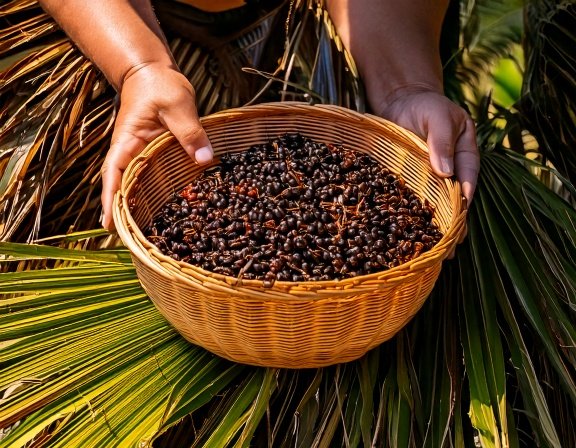
Saw Palmetto Benefits: How to Grow & Use for Prostate & Hair Health – A Guide for Men & Women
It is said that in every saw palmetto berry, nature offers gentle support for strength, balance and vitality inside and out. Saw palmetto is a remarkable palm native to the southeastern United States, best known for its rich, dark berries that have been used for generations to support men’s prostate health and, increasingly, women’s hair vitality. From growing your own saw palmetto at home to crafting natural remedies, this guide unpacks the science, tradition, and practical uses of this unique plant for holistic wellness. Whether you’re a man seeking urinary comfort or a woman hoping to strengthen hair and balance hormones, saw palmetto could be a powerful addition to your routine.



Download Now;
How to Grow Saw Palmetto for Lifelong Wellness
Saw palmetto (Serenoa repens) is a resilient, slow-growing palm native to the southeastern United States—particularly Florida and the coastal plains. Revered for centuries for its prostate and urinary health benefits, this hardy plant also makes an attractive, low-maintenance addition to wellness gardens and landscapes. With a little patience and the right care, you can cultivate saw palmetto at home for years of vitality and harvest potential.
Soil Requirements
Saw palmetto thrives in well-drained, sandy or loamy soil with low fertility. It naturally grows in coastal or scrubby areas, so it doesn’t need rich or heavily amended soil. Avoid heavy clay or compacted ground, which can hold too much moisture and cause root rot.
Light & Location
Choose a location with full sun to partial shade. Full sun encourages stronger berry production, while partial shade is suitable for decorative growth or container planting. It’s also salt-tolerant, making it a good choice for coastal gardens.
Watering Needs
Once established, saw palmetto is extremely drought-tolerant—one of the reasons it survives harsh, sandy environments. Water deeply after planting and during the first year, then reduce frequency. Overwatering can slow growth and attract fungal issues.
Planting & Spacing
When planting, space saw palmetto plants about 3–5 feet apart to allow room for their mature, spreading fronds. Dig holes only slightly larger than the root ball and avoid planting too deep. A thin mulch layer can help retain moisture during establishment but keep it away from the base to prevent rot.
Propagation
Propagation is typically done by seed, though patience is required—germination may take 2–6 months. Soak seeds in warm water for 24 hours before planting to speed up the process. Sow in sandy soil, keep lightly moist, and maintain warmth (around 80°F / 27°C). Transplant young plants once they reach several inches in height.
Maintenance & Care
Minimal care is best for this rugged plant. Prune only dead or damaged fronds to maintain a tidy shape. Avoid fertilizers or rich composts; saw palmetto naturally prefers nutrient-poor soils. Its slow growth and hardiness make it nearly pest-free and ideal for long-term sustainability gardens.
Quick Growing Tip
Saw palmetto grows slowly but lives for decades—sometimes over 500 years in the wild! Once established, it requires almost no upkeep and can provide year-round green foliage and seasonal medicinal berries that support men’s health and hormonal balance naturally.


How and When to Harvest Saw Palmetto Berries
Saw palmetto berries are the key to the plant’s renowned health benefits—especially for supporting prostate health, hormone balance, and urinary wellness. Harvesting them at the right time ensures maximum potency and nutrient concentration. Because the plant grows slowly and bears seasonally, timing and gentle handling are essential for a high-quality harvest.
When to Harvest
Berries typically ripen from late summer through early fall (August to October, depending on your climate). The best time to harvest is when the berries have turned a deep blue to black color and feel slightly soft to the touch. Immature green or red berries are less potent and should be left to ripen fully on the plant.
How to Harvest
Use gloves and long sleeves—saw palmetto fronds are sharp and spiny. Gently hand-pick the ripe berries early in the morning when the air is cool, helping to preserve their natural oils and freshness. Avoid pulling or damaging the plant base, as saw palmetto grows slowly and regenerates best when handled carefully.
Drying for Potency
Spread freshly picked berries in a single layer on mesh screens, trays, or paper in a shaded, well-ventilated area. Air-dry for 7–10 days until they are firm, wrinkled, and fully dry. Direct sunlight can degrade active compounds like fatty acids and sterols, so always dry in partial shade or indoors.
Storage & Preservation
Once dried, store berries in airtight glass jars or tins away from heat, moisture, and light. Properly dried and stored saw palmetto berries can last up to a year without losing potency. You can also process them immediately into tinctures, capsules, or herbal teas to lock in freshness and extract their active compounds.
Pro Tip
For the most therapeutic value, harvest at full ripeness and process quickly. Combining saw palmetto berries with herbs like nettle root or pumpkin seed can enhance hormonal and urinary support naturally.
Shop Saw Palmetto on Amazon
TruVarin: Varin-Rich Hemp, Saw Palmetto & Green Tea
- Features varin-rich hemp oil, peppermint, saw palmetto, green tea, caffeine
- All-natural actives for scalp support and fuller-looking hair
- Free from harsh chemicals—gentle on scalp and hair roots

Why Saw Palmetto? Science-Backed Benefits for Men and Women
- For Men’s Health: May reduce urinary frequency, urgency, and nighttime urination in BPH. Helps maintain a healthy balance of testosterone and DHT (dihydrotestosterone).
- For Women’s Health: By modulating DHT, saw palmetto can reduce hair thinning and support stronger, fuller hair. It may help balance androgens in women with hormonal hair loss (PCOS, etc).
- Other Potential Benefits: Reduces inflammation in the urinary tract. May ease mild acne related to hormonal imbalances.
- Active Compounds: Fatty acids (lauric, oleic, palmitic) & plant sterols (beta-sitosterol): synergistically support hormone health and block DHT’s effects on hair follicles and prostate tissue.
How to Use Saw Palmetto
- Traditional Tea: Simmer 1–2 tsp dried, crushed berries in water for 10–15 minutes; strain and enjoy 1–2 times daily.
- Capsules & Extracts: Follow product dosing; 160–320 mg/day of standardized extract is common.
- Tincture: Add a few drops to herbal tea or water as directed by a herbalist.
- Topical Scalp Oil: Infuse dried berries in a carrier oil for several weeks and massage into scalp (always patch test first).
TruVarin: Enriched Formula for Hair Strength & Growth
- Supports hair regrowth and reduces thinning or scalp discomfort
- Targets root causes of weak, brittle, or shedding hair
- Formulated for men and women struggling with hair loss
Subscribe to Health Intel Daily for expert wellness guides, herbal remedies, and holistic health tips for men and women—delivered right to your inbox!
Subscribe & Get Wellness Guides
References
- Grant, P. (2012). The role of saw palmetto in men’s health. Phytotherapy Research.
- Vogt, T. et al. (2020). Plant sterols and hair growth. Journal of Dermatological Science.
- Saw palmetto in BPH & hair loss—review
- Top Supplements for Women →